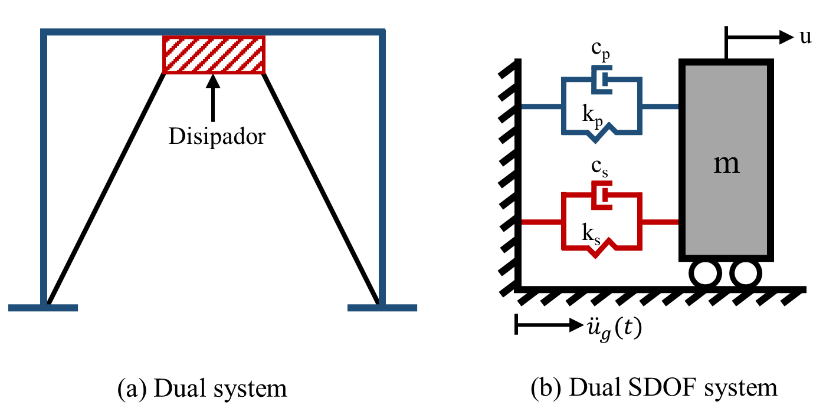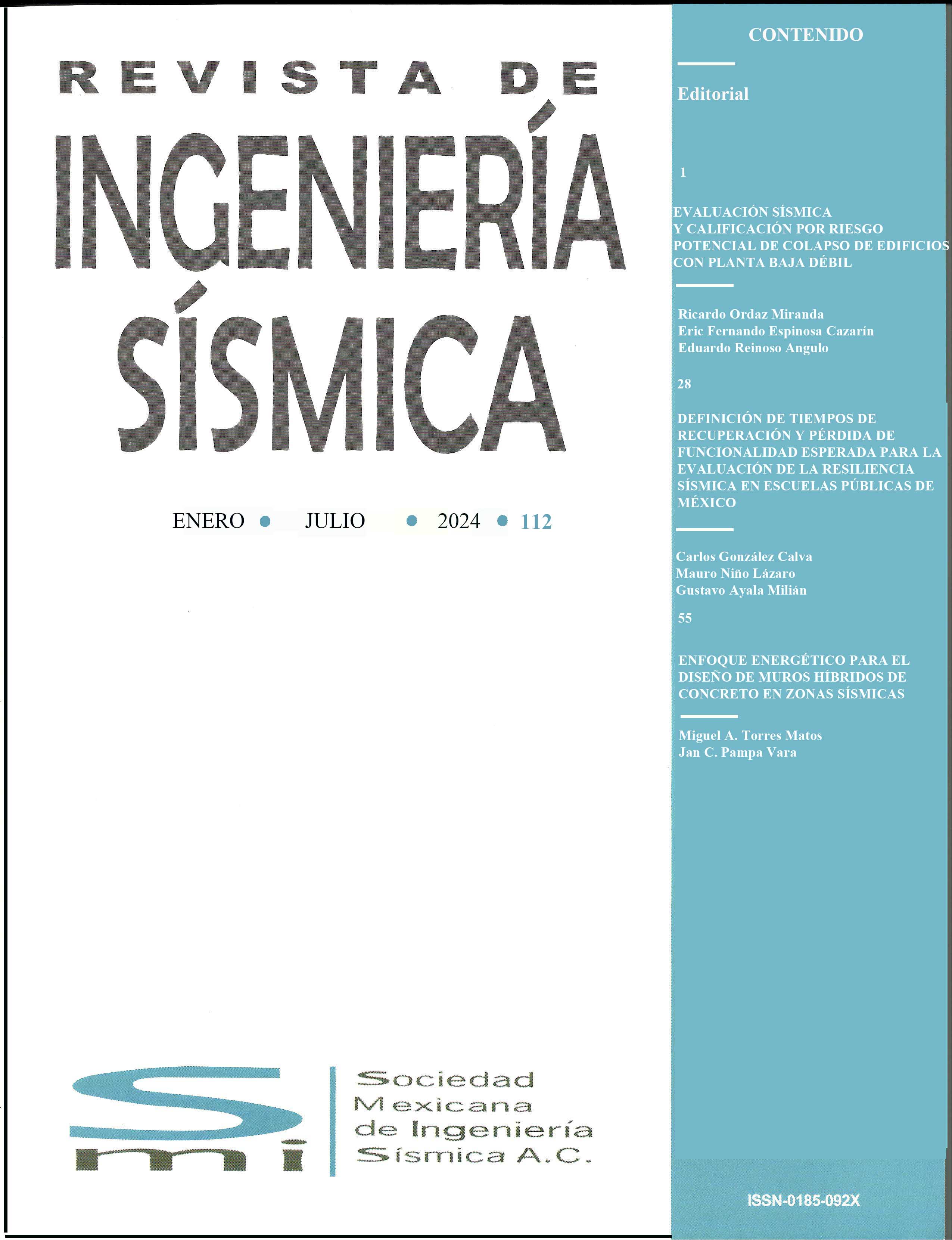FACTORES DE AMORTIGUAMIENTO PARA ESPECTROS DE DESPLAZAMIENTO DE SISTEMAS CON DISIPADORES DE ENERGÍA HISTERÉTICOS
DOI:
https://doi.org/10.18867/ris.105.542Palabras clave:
factores de amortiguamiento, espectro de desplazamientoResumen
Se propone y aplica una metodología basada en un análisis probabilista para estimar factores de amortiguamiento (Fmd) que modifican al espectro de desplazamiento elástico. Los Fmd toman en cuenta la disipación de energía de los sistemas disipadores del tipo histerético, así como el peligro sísmico del sitio donde se desplantan las estructuras. Se realizan análisis no lineales y lineales en el tiempo para sistemas de un grado de libertad equipados con disipadores de energía (S1GDL duales) y S1GDL convencionales, respectivamente. Se hace ver la influencia en los factores Fmd de los distintos parámetros de diseño y las características del suelo. Se obtienen expresiones matemáticas para los Fmd. los cuales resultan función del periodo de vibración de la estructura, de las características del sistema estructura-disipador y del tipo de suelo (duro, intermedio o blando) en donde se localizan los sistemas estructurales. Las expresiones son útiles para el diseño sísmico preliminar basado en el control de desplazamiento de sistemas estructurales equipados con disipadores del tipo histerético, ubicados en la ciudad de México.
Descargas
Citas
Abdollahzadeh, Banihashemi, Elkaee, y A Esmaeelnia (2012), “Response modification factor of dual moment-resistant frame with buckling restrained brace (BRB)”, 15th World Conference on Earthquake Engineering, Lisboa.
Arroyo-Espinoza, D y A Terán-Gilmore (2002), “Factores de reducción de fuerzas sísmicas para el diseño de estructuras con sistemas pasivos de disipación de energía”, Revista de Ingeniería Sísmica, Vol. 66, pp. 73-93. DOI: 10.18867/RIS.66.197
Asgarian, B y H R Shokrgozar (2009), “BRBF response modification factor”, Journal of Constructional Steel Research, Vol. 65, No.2, pp. 290-298. DOI: 10.1016/j.jcsr.2008.08.002
Avilés, J y L E Pérez-Rocha (1996), “Evaluation of interaction effects on the system period and the system damping due to foundation embedment and layer depth”, Soil Dynamics and Earthquake Engineering, Vol. 15, No.1, pp. 11-27. DOI: 10.1016/0267-7261(95)00035-6
Baber, T T y Y K Wen (1981), “Random vibration of hysteretic, degrading systems”, Journal of the Engineering Mechanics Division, Vol. 107, No. 6, pp. 1069-1087. DOI: 10.1061/JMCEA3.0002768
Bommer, J J y R Mendis (2004), “Scaling of spectral displacement ordinates with damping ratios”, Earthquake Engineering & Structural Dynamics, Vol. 34, No.2, pp. 145-165. DOI: 10.1002/eqe.414
Bouc, R (1967), “Forced vibration of mechanical system with hysteresis”, Proceedings 4th International Conference Nolinear Oscillations, Praga, Checoslovaquia.
Bozzo, L M, J Ramirez, J Bairan, G. Bozzo y E Muñoz (2020), “Precast buildings equipped with SLB seismic devices”, 17th World Conference on Earthquake Engineering, Sendai, Japón.
Cameron, J B, N Makris y I D Aiken (2004), “Component testing, seismic evaluation and characterization of buckling-restrained braces”, Journal of Earthquake Engineering, Vol. 130, No. 6, pp. 880-894. DOI: 10.1061/(ASCE)0733-9445(2004)130:6(880)
Cameron, W I y R A Green (2007), “Damping correction factors for horizontal ground-motion response spectra”, Bulletin of the Seismological Society of America, Vol. 97, No. 3, pp. 934-960. DOI: 10.1785/0120060034
Castillo, T y S E Ruiz (2013), “Factor de reducción por amortiguamiento para el diseño sísmico de estructuras con disipadores de energía”, Serie Azul 682, Instituto de Ingeniería, UNAM.
Castillo, T y S E Ruiz (2014), “Reduction factors for seismic design spectra for structures with viscous energy dampers”, Journal of Earthquake Engineering, Vol. 18, No. 3, pp. 323-349. DOI: 10.1080/13632469.2013.860932
Chopra, A K (2012), Dynamics of structures: theory and applications to earthquake engineering, fourth editions, Prentice Hall.
Cornell, C A (1968), “Engineering seismic hazard analysis”, Bulletin of the Seismological Society of America, Vol. 58, No. 5, pp. 1583-1606.
Del Valle, E (1988), “Amortiguamiento adicional para reducir efectos sísmicos”, Revista de Ingeniería Sísmica, Vol. 32, pp. 49-76. DOI: 10.18867/RIS.32.323
Esteva, L (1967), “Criterio para la construcción de espectros de espectros para diseño sísmico”, III Simposio panamericano de Estructuras, Caracas, Venezuela.
Foti, D, L Bozzo y F López-Almansa (1998), “Numerical efficiency assessment of energy dissipators for seismic protection of buildings”, Earthquake Engineering & Structural Dynamics, Vol. 27, No. 6, pp. 543-556. DOI: 10.1002/(SICI)1096-9845(199806)27:6<543::AID-EQE733>3.0.CO;2-9
Gaceta Oficial de la Ciudad de México (2017), Reglamento de Construcciones para el Distrito Federal, Ciudad de México.
Galvis, F, E Miranda, P Heresi, H Dávalos y J Ramón Silos (2017), “Preliminary statistics of collapsed buildings in Mexico City in the September 19, 2017 Puebla-Morelos Earthquake”, Stanford University.
Guerrero, H, T Ji, A Terán-Gilmore y J A Escobar (2016), “A method for preliminary seismic design and assessment of low-rise structures protected with buckling restrained braces”, Engineering Structures, Vol. 123, pp. 141–154. DOI: 10.1016/j.engstruct.2016.05.015
Hidalgo, J P y S E Ruiz (2010), “Factor de reducción β por incremento de amortiguamiento viscoso, para estructuras desplantadas sobre roca”, Revista de la Sociedad Mexicana de Ingeniería Sísmica, Vol. 83, pp. 1-23. DOI: 10.18867/RIS.83.142
Hurtado, F y L M Bozzo (2008), “Numerical and experimental analysis of a shear-link energy dissipator for seismic protection of buildings”, 14th World Conference on Earthquake Engineering, Beijing, China.
Jara, J M, A G Ayala y E Miranda (2000), “Seismic behaviour of structures with energy dissipating systems in Mexico”, 12th World Conference on Earthquake Engineering, Auckland, Nueva Zelanda.
Naeim, F y C A Kircher (2001), “On the damping adjustment factors for earthquake response spectra”, The Structural Design of Tall Buildings, Vol. 10, No. 5, pp. 361-369. DOI: 10.1002/tal.180
Nakashima, M, K Saburi y B Tsuji (1996), “Energy input and dissipation behavior of structures with hysteretic dampers”, Earthquake Engineering & Structural Dynamics, Vol. 25, No. 5, pp. 483-496. DOI: 10.1002/(SICI)1096-9845(199605)25:5<483::AID-EQE564>3.0.CO;2-K
Nangullasmú, H (2011), “Propuesta de criterios de diseño sísmico conforme al reglamento para marcos no dúctiles de concreto reforzado con disipadores histeréticos”, Tesis de Maestría, División de Ciencias Básicas e Ingeniería, UAM, México.
Nuzzo, I, D Losanno y N Caterino (2019), “Seismic design and retrofit of frame structures with hysteretic dampers: a simplified displacement-based procedure”, Bulletin of Earthquake Engineering, Vol. 17, pp. 2787-2819. DOI: 10.1007/s10518-019-00558-8
Ordaz, M y C Montoya (2014), “Programa DEGTRA, Versión 9.3.2”, Programa de cómputo, Instituto de Ingeniería, UNAM, México.
Orellana, M A, S E Ruiz y A Rodríguez-Castellanos (2021), “Displacement Spectra Damping Factors for Preliminary Design of Structures with Hysteretic Energy-Dissipation Devices”, Journal of Earthquake Engineering. DOI: 10.1080/13632469.2021.1913455
Priestley, M J N, G M Calvi y M J Kowalsky (2007), Displacement-based design of structures, Pavia, Italia: IUSS PRESS.
Reglamento de Construcciones para el Distrito Federal (2020), Normas Técnicas Complementarias para Diseño por Sismo, Gaceta Oficial de la Ciudad de México, México.
Rosenblueth, E y L Esteva (1972), “Reliability basis for some Mexican codes”, ACI, SP-31, pp. 1-41.
Ruiz, S E y H Badillo (2001), “Performance-based design approach for seismic rehabilitation of buildings with displacement-dependent dissipators”, Earthquake Spectra, Vol. 17, No. 3, pp. 531-548. DOI: 10.1193/1.1586187
Ruiz Gómez, S E, R Jiménez Jordán, M A Santos Santiago y M A Orellana Ojeda (2020), “Evaluación de la fragilidad de dos soluciones de rehabilitación para un edificio con planta baja débil dañado durante el sismo 19/S17”, Revista de Ingeniería Sísmica, No. 102, pp. 1 -25. DOI: 10.18867/RIS.102.513
Segovia, V y S E Ruiz (2017), “Direct displacement-based design for buildings with hysteretic dampers, using best combinations of stiffness and strength ratios”, Journal of Earthquake Engineering, Vol. 21, No. 5, pp. 752-775. DOI: 10.1080/13632469.2016.1185054
Servicio Sismológico Nacional (2017), “Reporte Especial: Sismo del día 19 de Septiembre de 2017, Puebla-Morelos (M 7.1)”, Universidad Nacional Autónoma de México (UNAM), Ciudad de México, México.
Shome, N y C A Cornell (1999), “Probabilistic Seismic Demand Analysis of Nonlinear Structures”, Report No. RMS-35, Department of Civil and Environmental Engineering, Stanford University, Stanford, USA.
Silva-González, F L (1998), “Calibración del método de linealización equivalente estocástica para sistemas histeréticos simples”, Tesis de Maestría, División de Estudios de Posgrado, UNAM, México.
Sues, R H, S T Mau y Y K Wen (1988), “Systems identification of degrading hysteretic restoring forces”, Journal of Engineering Mechanics, Vol. 114, No. 5, pp. 833-846. DOI: 10.1061/(ASCE)0733-9399(1988)114:5(833)
Terán-Gilmore, A y N Virto-Cambray (2009), “Preliminary design of low-rise buildings stiffened with buckling-restrained braces by a displacement-based approach”, Earthquake Spectra, Vol. 25, No. 1, pp. 185 -211. DOI: 10.1193/1.3054638
Vargas, R y M Bruneau (2009), “Analytical response and design of buildings with metallic structural fuses I”, Journal of Structural Engineering, Vol. 135. No. 4, pp. 386-393. DOI: 10.1061/(ASCE)0733-9445(2009)135:4(386)







